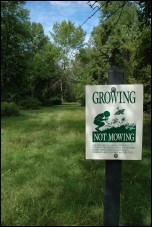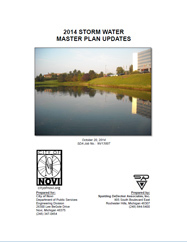The City of Novi is located within two major watersheds in southeast Michigan (the Rouge River Watershed and the Huron River Watershed). Novi is committed to protecting the water courses within and downstream of the community. The following information can be used as a guide to help the residents and commercial businesses of Novi properly manage their storm water runoff.
Information for Residents and Businesses
Information for Developers and Engineers
Storm Water Master Plan Update - October 2014
Information for Residents and Businesses
We can all make a difference in preserving and restoring the Rouge River. Some of the things we can do to help prevent pollution in the Rouge River include:
Lawn Care
Keep fertilizers, pesticides and herbicides off paved surfaces and out of drainage paths. When choosing a fertilizer, select a slow release formula. Fertilize in September or October to promote root growth rather than top growth. Visit the Ordinance website for fertilizer application ordinance information. (Chapter 12, Article VII).
Maintaining Your Storm Drain System and Detention Basin
Property owners can benefit from the City’s manual developed to provide guidance for maintaining the storm drain system and detention basin constructed for the subdivision or commercial property.
The manual can be accessed by clicking here
Automobile Maintenance
Direct polluted wash water away from streets and storm drains. Instead of washing your car in the driveway or street, wash your car on your lawn or go to a car wash.
Animal Waste
Clean up animal waste before it washes into the storm drain. You can throw it in the trash, preventing bacteria from entering the Rouge.
Home Care
Disconnect downspouts from sewer systems and direct them to vegetated areas away from building foundations. When cleaning up spills and leaks do not use your hose as a broom.
Toxic Materials
Properly dispose of household hazardous waste and call your local community to find out if they have a collection day. An even better solution is to use nontoxic alternatives whenever possible.
Get Involved!! Citizens can join Friends of the Rouge and/or participate in Rouge RiverWatch, River Stewards, storm drain stenciling, or other Rouge Friendly Neighborhood activities. Call 313-792-9900 for more information.
These voluntary actions will prevent pollutants from entering the Rouge River. Making these small changes in individual and household behaviors will make a big improvement in the water quality of the Rouge.
Healthy Lawns and Gardens = Healthy Rivers
Citizens can help prevent pollution in the Rouge River by participating in healthy lawn and garden practices. For instance, when soils and plants are healthy they naturally resist disease and pests, allowing gardeners and homeowners to reduce or eliminate the use of pesticides and fertilizers. Healthy lawn and garden practices save homeowners time and effort and promote a beautiful landscape.
There are six simple practices that individuals and homeowners can follow for a healthy lawn and garden. These principles include:
- Build fertile soils with organic matter such as compost or mulch. Use mulch (shredded leaves, grass clippings or compost) around plants and on the soil to resist weeds and retain moisture.
- Select plants suited for the site and climate conditions.
- Mow your grass at a high setting and let the short grass blades fall back onto the lawn.
- Select a slow-release fertilizer to promote steady, uniform growth.
- Mix grass clippings with leaves and soil to make a backyard compost pile.
- Reduce the use of insecticides, herbicides and other pesticides on your lawn or in your garden.
If you follow these simple principles you not only will have a healthy yard and garden, but you will also help prevent pollution in the Rouge River. All of our actions affect the river, so do your part to help prevent pollution.
Pets
Cleaning up after your pet is one way to help protect the Rouge River. Pet waste left on sidewalks, streets or yards contains numerous pollutants such as nutrients and bacteria. These pollutants can easily be washed into nearby storm drains and remember these storm drains dump directly to the River. Discard your pet's waste by double wrapping it in a plastic bag and throwing it in the garbage.
When washing your pet, do it either in the house in a laundry tub or outside in a washtub on the lawn. If you wash your pet outside, dump the washwater on the lawn when you are finished. These practices prevent polluted water from entering the storm drain. You can also help the environment by choosing a pet shampoo low in phosphorus.
Also, use nontoxic alternatives to flea powders and shampoos if possible. If you use a flea collar, dispose of it properly at a household hazardous waste collection site.
Don't feed the ducks and geese. Feeding these waterfowl is not healthy for them or the River. Like pet waste, waterfowl waste contributes nutrient and bacteria pollution to the Rouge River.
All of these practices can help to reduce and prevent pollution that enters the Rouge River, which will help to restore and protect the river.
Landscape for a Healthy Environment
 The way in which home landscapes are designed and maintained directly affects runoff and Rouge River water quality. Runoff results from rainstorms, snow melts and from lawn and garden watering practices. Some of the pollutants that can enter the river through runoff include fertilizer, pesticides, soil eroding from bare areas, pet wastes, and oil or grease that may have leaked or spilled onto the ground.
The way in which home landscapes are designed and maintained directly affects runoff and Rouge River water quality. Runoff results from rainstorms, snow melts and from lawn and garden watering practices. Some of the pollutants that can enter the river through runoff include fertilizer, pesticides, soil eroding from bare areas, pet wastes, and oil or grease that may have leaked or spilled onto the ground.
Landscapes can be designed to avoid these pollution problems. Some of these steps to avoid pollution in the Rouge River include:
- Designing landscapes to retain water onsite will encourage infiltration and even treat some pollutants through small ponds and wetlands.
- Selecting low maintenance trees, shrubs, and ground covers with water quality in mind will prevent pollution. This occurs simply by reducing the amount of chemical use such as pesticides and fertilizers as well as reduce water requirements.
- Reducing the amount of paved surfaces can reduce the volume and velocity of runoff, decreasing the amount of pollutants entering the river.
- Creating buffer zones of vegetation provides a greater opportunity for plants to slow and filter storm water.
Keep It On The Land
Erosion is the wearing away of soil from wind or water, and is often a concern on construction sites. Did you know it's also a concern in our own backyard?
Why be concerned about erosion?
When erosion occurs your backyard suffers because much of the good soil is lost. But it's not only your backyard, the Rouge River suffers as well. When eroded soil enters the River it causes the river to turn muddy. Not only is this ugly to look at, but it's caused all kinds of problems to the animals living in the water.
You Can Help
You can help prevent erosion in your backyard by following these tips:
- Place gravel or hardy vegetation under roof eaves to reduce the amount of sediments picked up by downspout runoff.
- Add downspout attachments to slow and spread the draining water.
- When landscaping or remodeling you can reduce erosion by covering small mounds of dirt with a tarp so that wind and rain don't carry these sediments to nearby water bodies like the Rouge River.
- Limit the extent and duration of land disturbance and protect surfaces once they are exposed.
- On exposed soil, by using mulches, such as straw or other plant residue, gravel or synthetic material you can create a protective blanket to reduce erosion. When applied to the soil surface, these mulches will minimize runoff, encourage vegetative growth, reduce evaporation, insulate the soil and suppress weed growth and provides immediate protection from erosion.
- Plant rapid-growing annual grasses or small grains. These can be used as temporary stabilization for erosion control on disturbed soils. This practice can be used on areas that will not be finished for more than one month.
Separately or combined, these erosion control measures can greatly reduce sediments entering the Rouge River. Keep Waste Out Of The River
Information for Developers and Engineers
Engineering Design Manual
Chapter 5 of the Engineering Design Manual provides specific, design, construction and maintenance standards for storm water management systems. The Engineering Design Manual can be viewed by clicking here.
Low Impact Development Manual for Michigan
Low impact development (LID) is the concept of storm water management with the goal of mimicking a site’s predevelopment hydrology by using design techniques that to keep storm water runoff close to its source. The Low Impact Development Manual for Michigan was developed to provide guidance on how to apply LID techniques, and can be accessed by clicking here.
 Storm Water Master Plan Update - October 2014
Storm Water Master Plan Update - October 2014
![]() Storm Water Master Plan Update
Storm Water Master Plan Update![]() Section 1 - Project Summary
Section 1 - Project Summary![]() Section 2 - Lexington Green
Section 2 - Lexington Green![]() Section 3 - Oakland Glens Mobile Home Park - Storm Water Flooding Concerns
Section 3 - Oakland Glens Mobile Home Park - Storm Water Flooding Concerns![]() Section 4 - Orchard Hill Place Basins - Condition and Capacity Concerns
Section 4 - Orchard Hill Place Basins - Condition and Capacity Concerns![]() Section 5 - Village Oaks Lane and Village Wood Lake - Infrastructure Access and Maintenance Concerns
Section 5 - Village Oaks Lane and Village Wood Lake - Infrastructure Access and Maintenance Concerns![]() Section 6 - Streambank Stabilization Evaluation and Recommendations
Section 6 - Streambank Stabilization Evaluation and Recommendations

